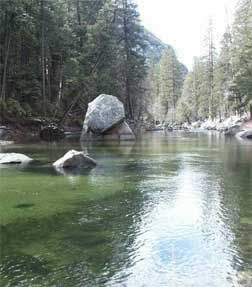
那是一个冬日,光线不多。不管怎样我找到一个漂亮的游泳池在西区的约塞米蒂山谷。这是一个快照的场景。
在低30′年代,它仅仅是温暖足以做一个丙烯画。因为丙烯酸树脂是水溶性的,很难漆在零度以下的天气!
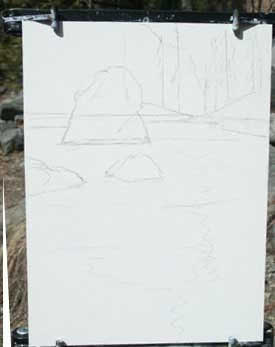
在定位我愿现场油漆,我的铅笔在速写的场景。我想要捕捉的颜色和反射的河,所以设置地平线高和大岩石顶部的绘画。 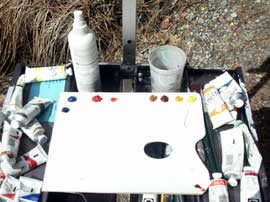
这是一杯我的调色板。当我在丙烯酸漆户外,我使用一个纸调色板。我不惹任何类型的“保持湿的调色板或盒子我通常涂料快速和使用喷雾瓶保持丙烯酸从干燥。
我这里包括Thalo调色板蓝、群青、二氢喹吖啶红、镉红中,生黄土,深褐色,Dialiryde黄、镉黄介质。我用其他颜色,但是在今天,这是我的选择。
在我得到太多的绘画,我通常混合结合深蓝色和二氢喹吖啶红形成一个紫色。我也有时Thalo混合蓝色和镉红中得到丰富的灰色。
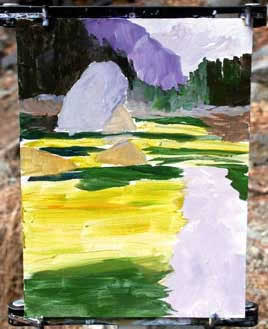
我下一个块快速一般的颜色。我做这个主要是为了摆脱白人以判断值更好的当我向前去。很多次我准备我的画布上涂着黄色赭石或深褐色调白。然而,今天,我开始只是一个白色的画布。
为背景,我使用混合的紫色。其他地区从混合灰色。水是黄色和蓝色Thalo Cad地中海。
我通常尝试让这个阶段干燥,在继续。户外用丙烯,这通常只需要几分钟。
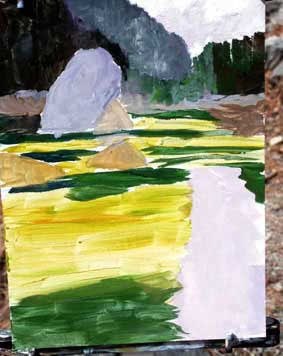
然后我开始工作背景的前锋。我通常的工作回到前面以便能够重叠前景对象更干脆地和容易与背景。
在这里我已经封锁在更多的遥远的山和天空。我使用相同的基本颜色与前面起见。
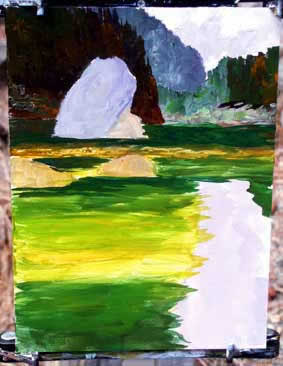
我工作整个绘画再一次,让一切另一层颜色。
我通常做至少三层完成对作品的每个部分都完成之前。丙烯画往往比石油更薄,这多个涂层技术构建不同的颜色在彼此给予更多的深度和感觉这幅画。
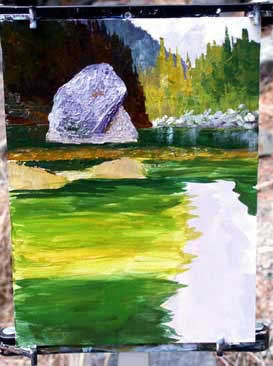
在这一点上,我开始把更多的细节在遥远的树木。我也工作远流银行多一点,增加更多的细节如岩石。我开始添加反射在遥远的水。
我开始添加一些黄土对水的中间,这是岩石在河的底部。
对于大型摇滚我切换到一个调色刀。油漆下面是放在相当厚形成一致性和雕塑的岩石。我使用了预混合的灰色和添加深褐色,预混合的紫色,有点黄土和其他人给摇滚更质地和颜色。
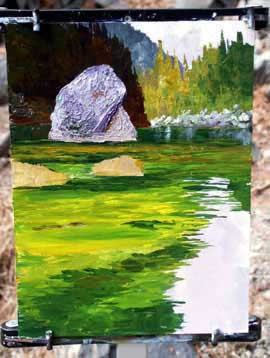
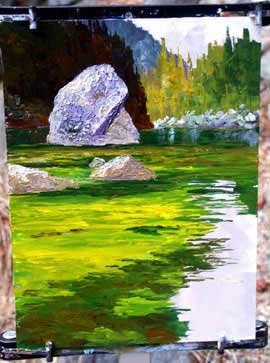
我也开始发展模式的反思和底部的池。
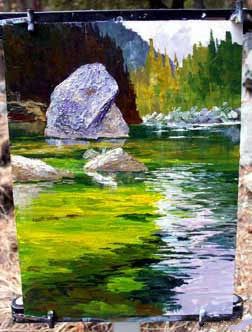
我继续工作在池、工作深绿叶蔬菜的反射光。
我也开始添加在反射光在池中。我通过在抹一点浅灰色顶部的反射,然后把它打倒我的手指。
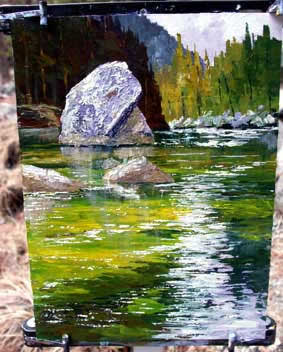
我继续添加更多的反射表面的水。因为在绘画是干燥的,就很容易拖累一抹浅灰色的白色来表示岩石的反思。我也添加一些白色闪烁在给的影响水闪闪发光。
丙烯酸树脂的优点之一在油是玻璃可以迅速对这一领域所做。与油,你将不得等待天画干为了达到同样的效果。
我花了将近两个小时的画,这是它看起来像我完成它在现场。
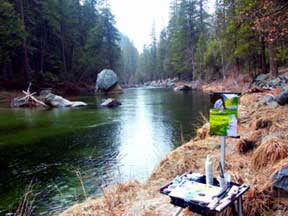
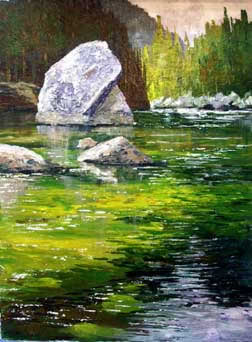
原文如下:
Acrylic Landscape Painting Tutorial By Donald Neff
It was a winter day and not much light. I did however locate a nice pool at the west end of Yosemite Valley. This is a snapshot of the scene.
In the low 30′s, it was barely warm enough to do an acrylic painting. Since acrylics are water soluble, it is difficult to paint in below freezing weather!
After locating the scene I wish to paint, I pencil in a quick sketch of the scene. I want to capture the colors and reflections of the river, so set the horizon line high with the large rock towards the top of the painting.
This is a shot of my palette. When I paint outdoors in acrylic, I use a paper palette. I don’t mess with any type of ‘stay-wet’ palettes or boxes as I usually paint fast and use a spray bottle to keep the acrylics from drying.
My palette here consists of Thalo Blue, Ultramarine Blue, Quinacridone Red, Cadmium Red Medium, Raw Sienna, Burnt Sienna, Dialiryde Yellow, and Cadmium Yellow Medium. I use other colors, but for today, that is my choice.
Before I get too much into the painting, I usually mix a combination of Ultramarine Blue and Quinacridone Red to form a purple. I also sometimes mix Thalo Blue and Cadmium Red Medium to get a rich gray.
I next block in quickly the general colors. I do this primarily to get rid of the white so as to judge values better as I go along. Many times I prepare my canvas with a coating of Yellow Ochre or Burnt Sienna to tone the white. However, today, I am starting with just a white canvas.
For the background, I am using the mixed purple. The other areas are from the mixed gray. The water is Cad Yellow Med and Thalo Blue.
I usually try to let this stage dry before going on. Outdoors with acrylics, this generally takes only a few minutes.
I then start working from the background forward. I usually work from the back to the front so as to be able to overlap foreground objects more crisply and readily against the background.
Here I have blocked in more of the distant mountain and the sky. I am using the same basic colors as the previous block-in.
I keep working forward, blocking in the tree line on the left, working the distant stream bank, then the stream itself. I am working more colors into the background such as Burnt Sienna in the stream bank.
I work the entire painting again, giving everything another coat of color.
I generally do at least three complete layers over every part of the painting before it is complete. Acrylics tend to be thinner than oil, and this multiple coating technique builds different colors over one another giving more depth and feeling to the painting.
At this point, I start putting more detail in the distant trees. I also work the far stream bank a little more, adding more detail such as the rocks. I start adding reflections in the distant water.
I start adding some Sienna to the water in the middle ground which are the rocks in the bottom of the river.
For the large rock I switch to a palette knife. The paint here is laid on fairly thick to form the consistency and sculpture of the rock. I use the premixed Gray and add Burnt Sienna, premixed Purple, a little Sienna and others to give the rock more texture and color.
I now work further on the pool of water. The green is quite brilliant, so I use primarily a mixture of Thalo Blue and Cadmium Yellow Medium. For the darks in the stream bottom, I add Burnt Sienna, and sometimes the purple which I mix from Ultramarine Blue and Quinacridone Red.
I continue working on the foreground pool and begin to sculpt in the smaller rocks with thick paint and a palette knife. I used the premixed gray along with Sienna for these rocks.
I also begin to develop the reflections and patterns in the bottom of the pool.
I continue to work on the pool, working the deep greens into the reflected light.
I also start adding in the reflected light in the pool. I do this by dabbing a little light gray at the top of the reflection and then pull it down with my finger.
I keep adding more reflection on the surface of the water. Since the under painting is dry, it is easy to drag down a wash of grayish white to indicate the reflections of the rocks. I also add some white sparkles around to give the effect of the glinting water.
One of the advantages of acrylics over oils is glazing can be quickly done in the field. With oils, you would have to wait days for the painting to dry in order to accomplish the same effect.
I spent just under two hours on the painting, and this is the way it looked as I was finishing it on the scene.
Here is a photo of the scene when close to finished with the painting. I forgot to mention, it rained, sleeted and hailed while doing this study. You can read more about that day and painting on my weblog.
Here is the final painting. After I got home, I realized the light reflection in the water detracted from the overall scene, so painted some of it out and grayed out the rest.








